Growing your own herbs indoors can be a rewarding hobby, providing fresh flavors for your kitchen year-round. Not only does it offer cost savings and health benefits, but it also allows you to enjoy the satisfaction of nurturing your own plants.
Indoor herb gardening is accessible to everyone, regardless of your experience level. This guide will walk you through the basics, from setting up your indoor garden to tips for maintaining healthy, thriving plants. Whether you’re looking to enhance your cooking or simply enjoy the benefits of having plants indoors, this guide is designed to help you get started.
Key Takeaways
- Learn the benefits of indoor herb gardening
- Discover how to set up your indoor herb garden
- Understand the basics of maintaining healthy herb plants indoors
- Get tips on growing a variety of herbs in your indoor garden
- Explore the cost savings and health benefits of indoor herb gardening
The Benefits of Growing Herbs Indoors
Having an indoor herb garden can be a game-changer for home cooks and health enthusiasts alike. It offers a multitude of benefits that can enhance your culinary experiences and overall well-being.
Year-Round Fresh Herbs
Growing herbs indoors allows you to have fresh herbs at your fingertips throughout the year, regardless of the season. This means you can enjoy your favorite dishes with the freshest flavors, even in the middle of winter.
Cost Savings Over Store-Bought Herbs
By cultivating your own herbs indoors, you can significantly reduce your expenditure on store-bought herbs. Fresh herbs can be expensive, especially if you use them frequently. Here’s a comparison of the costs:
| Herb | Average Store Price | Indoor Garden Cost |
|---|---|---|
| Basil | $2.50 per bunch | $0.25 per harvest |
| Cilantro | $1.50 per bunch | $0.15 per harvest |
Health and Wellness Benefits
Indoor herb gardening not only provides fresh flavors but also contributes to a healthier lifestyle. Being surrounded by greenery can boost your mood and reduce stress. Additionally, having easy access to fresh herbs encourages you to incorporate more nutrients into your diet.
Understanding the Basics: A Beginner’s Guide to Herb Gardening Indoors
Starting an indoor herb garden is a straightforward process that can enhance your cooking and well-being. To get started, it’s essential to understand the fundamental requirements for growing herbs indoors.
Light Requirements
Most herbs need 4-6 hours of sunlight per day. Placing them near a sunny window or using grow lights can help meet this requirement. Proper lighting is crucial for healthy herb growth.
Temperature Considerations
Herbs generally thrive in temperatures between 65-75°F. Keeping them away from drafts and extreme temperatures will help maintain a stable environment.
Humidity Needs
Moderate humidity is ideal for most herbs. You can increase humidity around your plants by using a humidifier or placing the pot on a tray filled with water and pebbles.
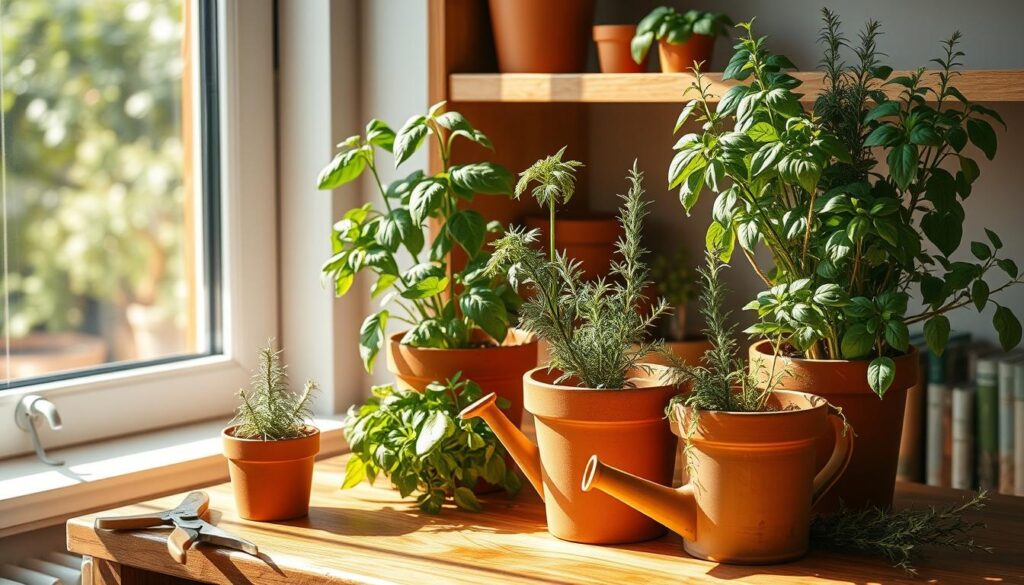
| Factor | Ideal Condition |
|---|---|
| Light | 4-6 hours of sunlight |
| Temperature | 65-75°F |
| Humidity | Moderate |
By understanding and meeting these basic needs, you can create a thriving indoor herb garden. This foundational knowledge will help you grow a variety of herbs successfully.
Essential Supplies for Your Indoor Herb Garden
Before you begin planting your indoor herbs, it’s crucial to have the right supplies. Having the correct equipment not only makes the process easier but also ensures the health and vitality of your herbs.
Containers and Pots
Choosing the right containers is vital for the health of your herbs. Opt for pots that have drainage holes to prevent waterlogged soil. The material can vary, but ensure it’s clean and dry before use. Terracotta and ceramic pots are popular choices due to their breathability and aesthetic appeal.
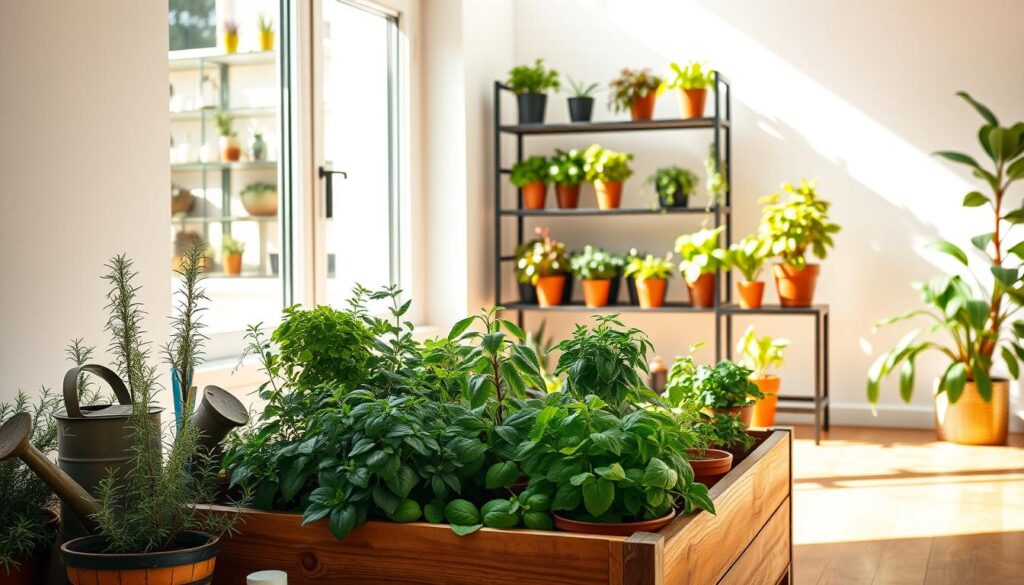
Soil and Growing Medium
A good quality potting mix is essential for indoor herb gardening. It should be well-draining and rich in organic matter. Avoid using garden soil from your outdoor garden, as it can compact and prevent proper drainage. Consider mixes specifically designed for indoor plants or herbs.
Tools and Accessories
Basic gardening tools such as a watering can, pruning scissors, and a small trowel are necessary. You may also consider a watering globe or a moisture meter to help manage watering. Keep your tools clean to prevent the spread of disease.
By gathering these essential supplies, you’ll be well on your way to creating a thriving indoor herb garden.
Choosing the Perfect Location
To ensure your herbs thrive, it’s essential to pick the right spot in your home. The location of your indoor herb garden can significantly impact the health and productivity of your plants.
Window Placement Options
Most herbs require plenty of sunlight to grow well. South- or west-facing windows are ideal for many herbs, as they provide the necessary light. If you have a window that receives direct sunlight for at least 4-6 hours a day, it’s a great spot for your herb garden.
Tips for Window Placement:
- Ensure the window is clean to maximize sunlight.
- Keep herbs at least 6-8 inches away from the window to prevent overheating.
- Rotate your plants regularly to ensure even growth.
Using Artificial Light
If you don’t have a suitable window or if the natural light is insufficient, consider using artificial lighting. LED grow lights are a popular choice for indoor herb gardens because they are energy-efficient and provide the necessary spectrum for plant growth.
| Lighting Type | Benefits |
|---|---|
| LED Grow Lights | Energy-efficient, long-lasting, and adjustable spectrum |
| Fluorescent Lights | Affordable and effective for seedlings and herbs |
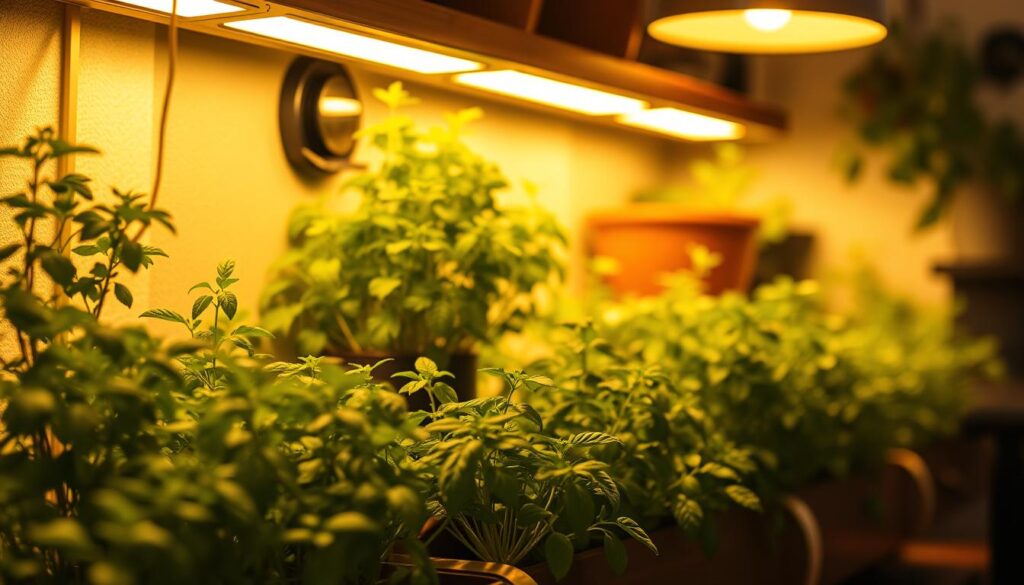
Best Herbs for Indoor Growing
When it comes to indoor herb gardening, selecting the right herbs is crucial for a thriving garden. The best herbs for indoor growing are those that are adaptable to indoor conditions and can thrive with proper care.
Easy Herbs for Beginners
For those new to indoor herb gardening, starting with easy-to-grow herbs is the key to success. Basil, mint, and chives are excellent choices for beginners. They are hardy, require minimal care, and can thrive in a variety of conditions.
Basil, Mint, and Chives
Basil adds a fresh flavor to many dishes, mint is great for teas and cocktails, and chives provide a mild onion flavor. These herbs are not only delicious but also relatively low maintenance.
Parsley, Thyme, and Oregano
Other herbs like parsley, thyme, and oregano are also great for beginners. Parsley is rich in vitamins and can be used as a garnish, thyme is perfect for soups and stews, and oregano is a staple in Italian and Greek cuisine.
Herbs That Thrive in Low Light
Not all herbs require direct sunlight. Some, like parsley and thyme, can thrive in low light conditions, making them perfect for rooms that don’t receive a lot of natural light.
Herbs That Need More Light
On the other hand, herbs like basil and mint need more light to grow well. Placing them near a sunny window or using grow lights can help them thrive.
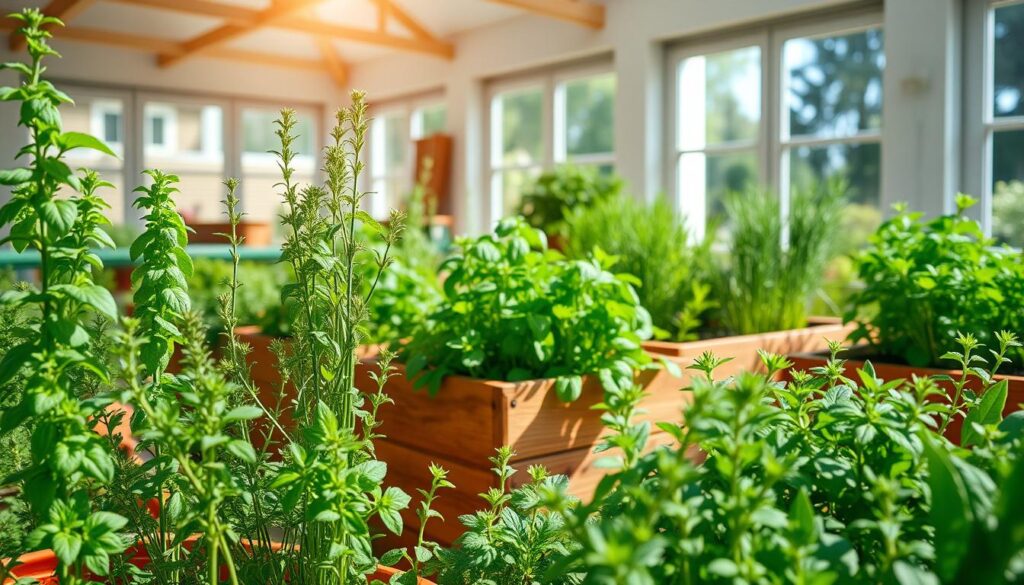
“The garden is a love song, a duet between a human being and Mother Nature.”
Choosing the right herbs for your indoor garden can be a rewarding experience, and with the right care, you can enjoy fresh, fragrant herbs all year round.
Starting Your Indoor Herb Garden
Creating an indoor herb garden is a simple and effective way to have fresh herbs at your fingertips. Whether you’re a seasoned gardener or a beginner, starting an indoor herb garden can be a rewarding experience.
Starting from Seeds
Starting your indoor herb garden from seeds allows you to control the growing conditions from the very beginning. To sow seeds successfully, use a good quality seed starting mix and ensure the soil is moist but not waterlogged. Most herb seeds require light to germinate, so sow them on the surface or just barely cover them with soil.
Tips for Sowing Seeds:
- Use a clean container with drainage holes.
- Sow seeds according to the package instructions.
- Keep the soil consistently moist.
Starting from Seedlings or Cuttings
Starting your indoor herb garden from seedlings or cuttings can give you a head start on the growing season. Seedlings are young plants that have already germinated and are ready to be transplanted into larger containers. Cuttings, on the other hand, involve taking a part of a mature herb plant and encouraging it to grow roots.
| Method | Advantages | Disadvantages |
|---|---|---|
| Seeds | Cost-effective, control over growing conditions | Longer time to harvest |
| Seedlings | Faster growth, already started | May be more expensive than seeds |
| Cuttings | Quick results, preserves plant characteristics | Requires a mature plant to start with |
Different Indoor Herb Gardening Methods
Indoor herb gardening techniques range from traditional to highly innovative systems, offering a variety of options for gardeners of all levels.
Traditional Potted Herbs
Traditional potted herbs are a straightforward and familiar method for growing herbs indoors. This technique involves planting herbs in pots filled with soil, providing a simple and effective way to have fresh herbs at your fingertips. Choosing the right pot size and soil type is crucial for the health and productivity of your herbs.
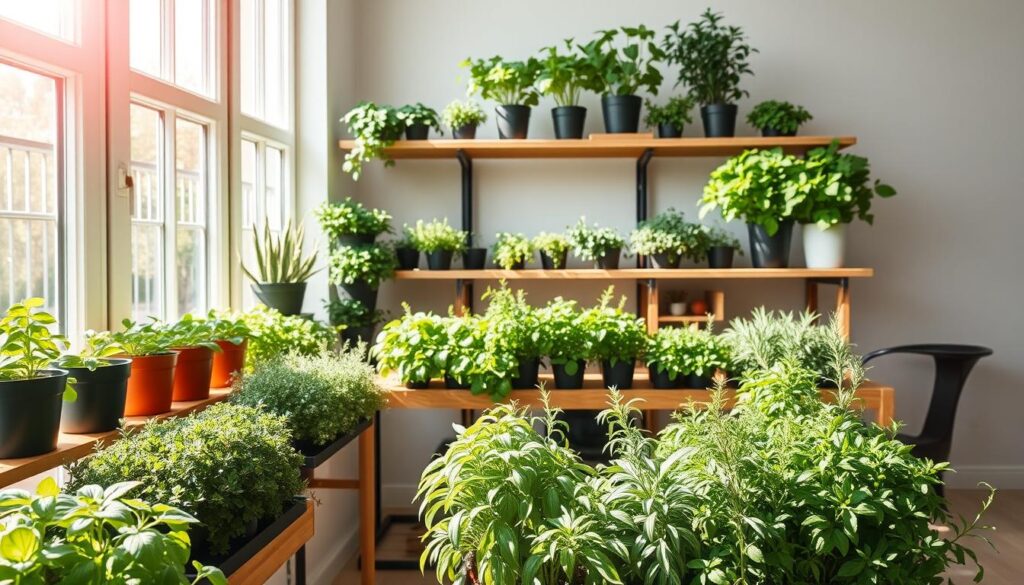
Hydroponic Systems
Hydroponic systems represent a more advanced and efficient method of indoor herb gardening. By delivering nutrients directly to the roots through a water-based solution, hydroponics can significantly enhance herb growth and reduce water consumption. This method is ideal for those looking for a more controlled and precise gardening experience.
Vertical Herb Gardens
Vertical herb gardens are an innovative solution for maximizing space in indoor gardening. These systems allow for multiple herbs to be grown in a compact, layered arrangement, making them perfect for small kitchens or apartments. Vertical gardens can be a stylish addition to any room, combining functionality with aesthetic appeal.
By exploring these different indoor herb gardening methods, you can select the approach that best fits your lifestyle, space, and gardening goals.
Proper Planting Techniques
To get the most out of your indoor herb garden, it’s crucial to master proper planting techniques. This involves preparing your containers correctly and understanding the right planting depth and spacing for your herbs.
Container Preparation
Preparing your containers is a critical step in creating a healthy indoor herb garden. Start by selecting containers that have good drainage holes to prevent waterlogged soil. Use a well-draining potting mix specifically designed for indoor plants. Before planting, gently clean your containers with a mild soap solution to remove any residue that might affect plant growth.
For beginners, it’s also essential to choose containers that are the right size for the herbs you plan to grow. Larger containers can be more forgiving if you forget to water from time to time. Consider using self-watering pots or containers with built-in water reservoirs as part of your indoor herb garden essentials.
| Container Type | Drainage | Size |
|---|---|---|
| Terracotta | Good | Variable |
| Plastic | Variable | Variable |
| Self-Watering | Excellent | Variable |
Planting Depth and Spacing
Correct planting depth and spacing are vital for the healthy growth of your herbs. Planting too deeply can cause the stem to rot, while too shallow can expose the roots. A general rule is to plant the herb at the same depth as it was in its original pot. For spacing, most herbs need about 6-8 inches between each plant to allow for air circulation and growth.
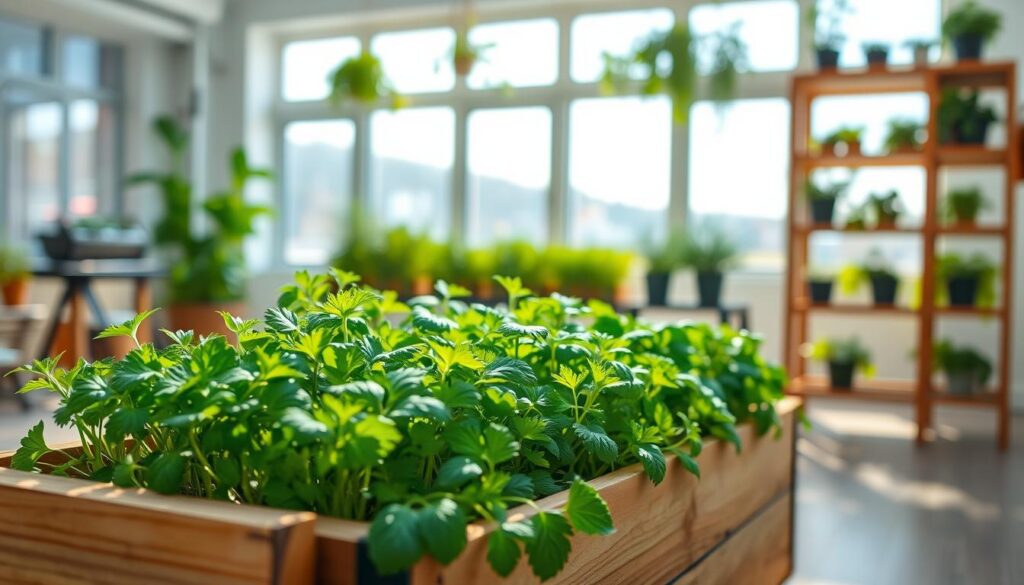
For growing herbs indoors for beginners, start with herbs that are known to be easy to grow, such as basil, mint, or chives. These herbs are forgiving and can thrive in indoor conditions with proper care. Remember, the key to a successful indoor herb garden is attention to detail and a willingness to learn and adapt your techniques as needed.
Watering Your Indoor Herbs Correctly
Proper watering techniques are essential for maintaining a healthy indoor herb garden. Watering your herbs correctly ensures they receive the right amount of moisture to thrive.
Signs of Overwatering and Underwatering
Checking soil moisture is crucial, as both overwatering and underwatering can be detrimental to your herbs. Overwatering can lead to root rot and other problems, while underwatering can cause stress and reduce herb quality.
Signs of overwatering include yellowing leaves, soft stems, and a musty smell from the soil. On the other hand, underwatering can be identified by dry, crispy leaves and slow growth. Adjusting your watering schedule based on these signs can help prevent these issues.
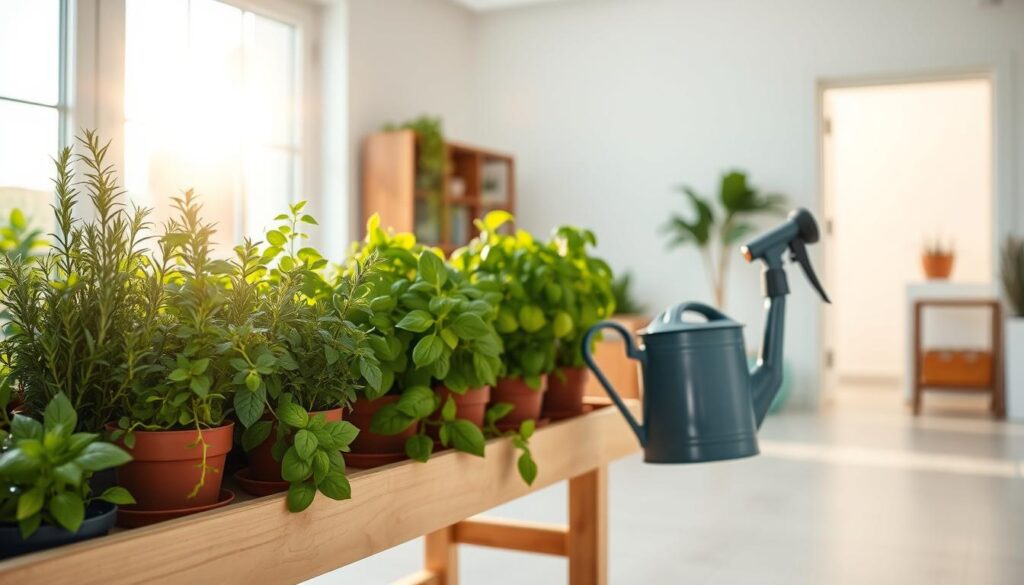
Watering Techniques and Schedules
To water your indoor herbs correctly, check the soil moisture by inserting your finger into the soil up to the first knuckle. If the soil feels dry, it’s time to water. Water thoroughly until you see water draining out of the container’s bottom holes.
Establishing a watering schedule can help maintain consistency. Generally, indoor herbs need watering once a day, but this can vary based on the herb type, container size, and environmental conditions. Monitoring your plants and adjusting the schedule as needed is key to successful indoor herb gardening.
Seasonal Considerations for Indoor Herb Gardens
To keep your indoor herb garden flourishing, it’s essential to understand the seasonal considerations that impact its health and productivity. While indoor gardens are somewhat shielded from outdoor seasonal changes, there are still important adjustments to make throughout the year.
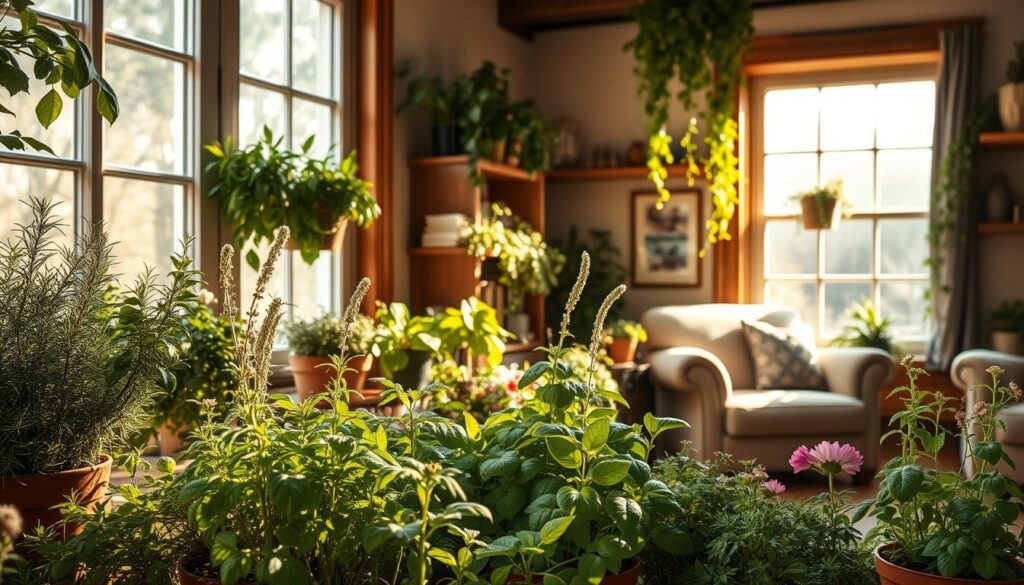
Winter Care Tips
During the winter, indoor herb gardens face challenges such as colder temperatures and reduced daylight hours. To combat these issues:
- Keep your herbs away from drafty windows and doors to prevent cold damage.
- Consider using grow lights to supplement the reduced natural light, ensuring your herbs get enough light to photosynthesize.
- Maintain a consistent temperature between 65-75°F (18-24°C) to promote healthy growth.
By taking these steps, you can help your indoor herbs survive and even thrive during the winter months.
Summer Adjustments
In the summer, indoor herb gardens may require different care due to warmer temperatures and potentially increased humidity. Some tips include:
- Monitoring the temperature to ensure it doesn’t get too hot, as most herbs prefer daytime temperatures around 75°F (24°C) and slightly cooler at night.
- Adjusting your watering schedule, as herbs may need more water during the warmer months due to increased evapotranspiration.
- Ensuring good air circulation around your plants to prevent fungal diseases that thrive in humid conditions.
By making these adjustments, you can keep your indoor herb garden healthy and productive throughout the summer.
Common Problems and Solutions
While indoor herb gardening is relatively easy, there are common issues to watch out for. Being aware of these potential problems can help you maintain a healthy and thriving herb garden.
Pest Management
Indoor herb gardens can sometimes attract pests like aphids, spider mites, and mealybugs. To manage these pests, regularly inspect your plants and use organic pest control methods whenever possible. Neem oil and insecticidal soap are effective treatments for many common pests.
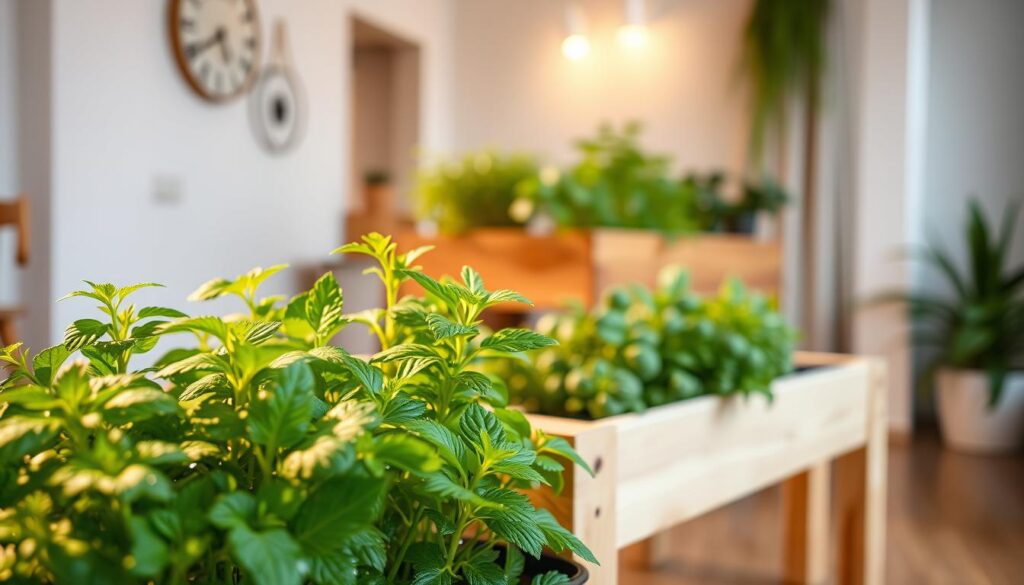
Disease Prevention
Diseases can be a significant issue in indoor herb gardens, often caused by overwatering or poor air circulation. To prevent disease, ensure your herbs are not waterlogged and have enough space between plants for air to circulate. Fungal diseases can be treated with fungicides, but prevention is always the best approach.
Troubleshooting Growth Issues
If your herbs are not growing as expected, check for common issues like insufficient light, incorrect watering, or nutrient deficiencies. Adjusting your indoor herb gardening techniques based on the specific needs of your herbs can help resolve these problems. Regularly fertilizing your herbs can also promote healthy growth.
Harvesting and Using Your Herbs
As your indoor herbs reach maturity, learning the proper techniques for harvesting and using them will enhance your culinary creations. Regular harvesting not only provides you with fresh ingredients but also encourages the plants to produce more leaves, promoting continued growth and health.
When and How to Harvest
Harvesting your herbs at the right time is crucial. For most herbs, the best time is in the morning, after the dew has dried but before the heat of the day. Pinch or cut off the leaves or stems as needed, making sure to take no more than one-third of the plant’s foliage to avoid stressing it.
Pruning for Continued Growth
Pruning is an essential step in maintaining the health and productivity of your indoor herbs. By regularly trimming back your herbs, you encourage bushy growth and prevent the plants from flowering and going to seed.
Preserving Extra Herbs
When you have a bountiful harvest, preserving some for later use is a great idea. You can dry herbs by tying them in small bunches and hanging them upside down, or use a dehydrator. Freezing is another excellent method, either on their own or mixed into ice cube trays with a little water or olive oil.
| Herb | Best Harvest Time | Preservation Method |
|---|---|---|
| Basil | Morning | Freezing or drying |
| Mint | Anytime | Drying or making into ice cubes |
| Cilantro | Morning | Freezing |
Conclusion
With the right knowledge and supplies, anyone can start an indoor herb garden and enjoy the benefits of fresh, home-grown herbs. By following this beginner’s guide to herb gardening indoors, you’ve learned the essential steps to create a thriving indoor herb garden.
From understanding the basics of herb gardening to choosing the perfect location and selecting the best herbs for indoor growing, you’ve gained the confidence to start your indoor herb gardening journey. Remember to focus on indoor herb garden essentials, such as proper lighting, watering, and pruning, to ensure the continued health and growth of your herbs.
As you begin starting an indoor herb garden, don’t be afraid to experiment and try new things. With a little practice and patience, you’ll be harvesting fresh herbs in no time. So, get started today and enjoy the many rewards of indoor herb gardening.



